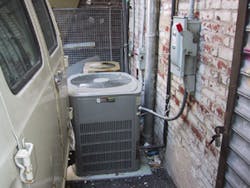As usual, never consider the following commentary associated with these photos as a formal interpretation of the National Electrical Code (NEC). Without criticizing anyone or any product, the following scenarios present us with serious electrical safety questions.
Unguarded EquipmentYou can send Code Violations Illustrated stories and photos directly to Joe Tedesco at:
Joe Tedesco
350 North Street
Boston, MA 02113
or e-mail: [email protected]
If you mail pictures, please include the story, location, and some information about yourself — and please do not write on the front or back of your photo. Please send all digital images in JPEG format. You can send photos while visiting Joe's Web site at: www.joetedesco.com
About the Author
Joe Tedesco
Tedesco served the industry in many roles during his career. He was a director, senior electrical code instructor for National Technology Transfer, Inc. and American Trainco, Inc.. He was also a codes, standards and seminar specialist for the International Association of Electrical Inspectors and an electrical field service specialist for the National Fire Protection Association in Quincy, Mass. He ran his own business as an NEC consultant and is a Massachusetts licensed master electrician and journeyman electrician and certified electrical inspector (one and two family 2A; General 2B, and Plan Review, 2C). Tedesco also wrote articles for CEE News and EC&M (Code Violations Illustrated and What's Wrong Here?) for more than 15 years and helped launched the Moving Violations video series.
